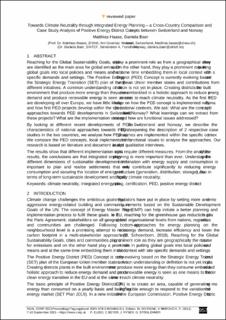| dc.contributor.author | Haase, Matthias | |
| dc.contributor.author | Baer, Daniela | |
| dc.date.accessioned | 2021-12-09T08:30:25Z | |
| dc.date.available | 2021-12-09T08:30:25Z | |
| dc.date.created | 2021-11-27T14:25:53Z | |
| dc.date.issued | 2021 | |
| dc.identifier.isbn | 978-3-9504945-0-1 | |
| dc.identifier.uri | https://hdl.handle.net/11250/2833505 | |
| dc.description.abstract | Reaching for the Global Sustainability Goals, cities play a prominent role as from a geographical view they are identified as the main area for global emissions. On the other hand, they play a prominent role in putting global goals into local policies and means and at the same time embedding them in local context with site specific demands and settings. The Positive Energy District (PED) Concept is currently evolving based on the Strategic Energy Transition (SET) plan of the European Union member states and contributions from different initiatives. A common understanding or definition is not yet in place. Creating districts in the built environment that produce more energy than they consume embedded in a holistic approach to reduce energy demand and produce renewable energy is seen as one means to reach climate neutrality. As the first PEDs are developing all over Europe, we have little knowledge on how the PED concept is implemented nationally and how first PED projects develop within the specific national contexts. We ask: What are the concepts and approaches towards PED developments in Switzerland and Norway? What learnings can we extract from these projects? What are the implementation strategies and how are functional issues addressed?
By looking at different recent developments of PEDs in Switzerland and Norway, we describe the characteristics of national approaches towards PEDs. By deepening the description of 2 respective casestudies in the two countries, we analyse how PED approaches are implemented within the specific context. We compare the PED concepts, local implementation and functional issues to analyse the approaches. Our research is based on literature and document analysis and qualitative interviews.
The results show that different implementation concepts require different measures. From the analysis of the results, the conclusions are that integrated energy planning is more important than ever. Understanding the different dimensions of sustainable development in combination with energy supply and consumption is important to plan and realise settlements that not only contribute significantly to reducing energy consumption and securing the location of energy infrastructure (generation, distribution, storage), but also in terms of long-term sustainable development and specifically climate neutrality. | |
| dc.language.iso | eng | |
| dc.publisher | CORP | |
| dc.relation.ispartof | REAL CORP 2021: CITIES 20.50. Creating Habitats for the 3rd Millennium. Smart – Sustainable – Climate Neutral. Proceedings of 26th International Conference on Urban Planning, Regional Development and Information Society | |
| dc.rights | CC BY 4.0 | |
| dc.rights.uri | https://creativecommons.org/licenses/by/4.0/deed.en | |
| dc.subject | Climate neutrality | |
| dc.subject | Integrated energy planning | |
| dc.subject | Certification | |
| dc.subject | PED | |
| dc.subject | Positive energy districts | |
| dc.title | Towards Climate Neutrality through Integrated Energy Planning – a Cross-Country Comparison and Case Study Analysis of Positive Energy District Concepts between Switzerland and Norway | |
| dc.type | Chapter | |
| dc.type | Peer reviewed | |
| dc.type | Conference object | |
| dc.description.version | publishedVersion | |
| dc.rights.holder | © 2021 The Authors. | |
| dc.subject.nsi | VDP::Teknologi: 500 | |
| dc.source.pagenumber | 957-967 | |
| dc.identifier.cristin | 1960188 | |
| dc.relation.project | Norges forskningsråd: 257660 | |
| cristin.ispublished | true | |
| cristin.fulltext | original | |

